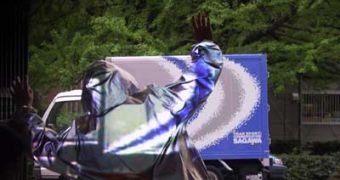The subject of invisibility has been obsessing human beings ever since they were able to imagine how it would be like to be unseen by others. Mythology is full of examples: the ring of Gyges is described in a story in Plato's The Republic. A peasant finds a ring in the tomb of a dead king which allows him to become invisible at will, to seduce the queen and plot to kill the king.
Going undetected is not only every man's fantasy (the person who claims that he has never wondered what it would be like to be invisible is lying), but also the military, who see this as the ultimate stealth capability.
A mathematician at the University of Liverpool designed a unique computer model that shows that it is possible to make objects, such as aeroplanes and submarines, appear invisible at close range. From a distance, it's easier to become nearly invisible with camouflage, an art performed by many animals, plants, and even army snipers, but the closest you get to the "invisible" object, the more chances are that the eye will eventually distinguish known patterns, especially when trained to do so.
Scientists have already developed theoretical and even practical models of "invisibility cloaks", using metamaterials. These nanofabricated photonic materials, (metamaterials, a class of materials having properties not found in naturally-formed substances, but gained from their artificially created structure), have not only been used to create the first optical superlens, but have also been proposed as a mechanism for building a cloaking device by surrounding the object to be cloaked with a shell that affects the passage of light near it.
But only from far away. Dr S?bastien Guenneau, mathematician at the University of Liverpool together with Dr Fr?d?ric Zolla and Professors Andr? Nicolet from the University of Marseille, have proven - using a specially designed computer model called GETDP - that objects can also be made to appear invisible from close range when light travels in waves rather than beams.
"In order for the cloaking device to work in the first place light has to separate into two or more waves resulting in a new wave pattern. Within this pattern we get light and dark regions which are needed in order for an object to appear invisible," said Guenneau.
"Until now, however, it was not clear whether photons - particles that make up all forms of light - can split and form new waves when the light source is close to the object. If we use ray optic techniques - where light travels in beams - photons break down at close range and the object does not appear invisible. If we study light as it travels in waves however, invisibility is maintained."
The new theoretical models could help develop future applications that would help make material objects of fixed size look invisible, even from a small distance.

 14 DAY TRIAL //
14 DAY TRIAL //